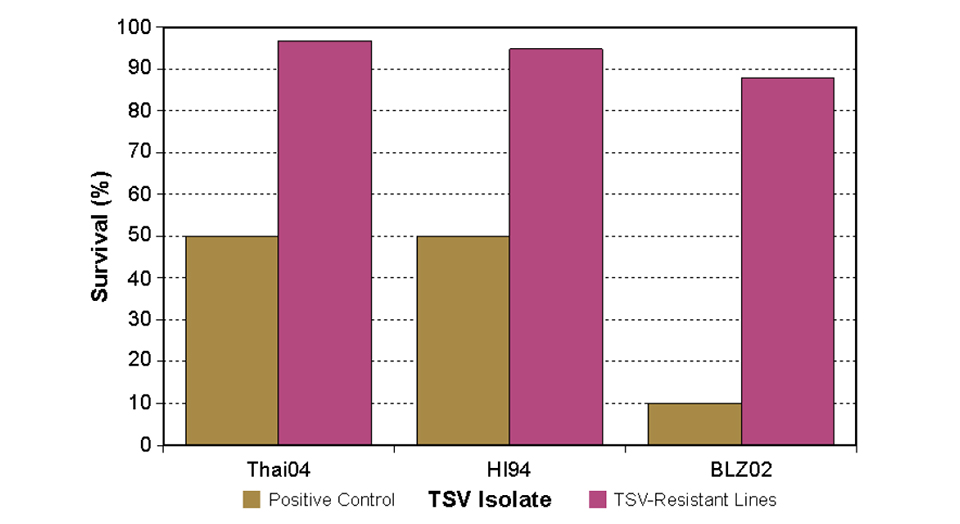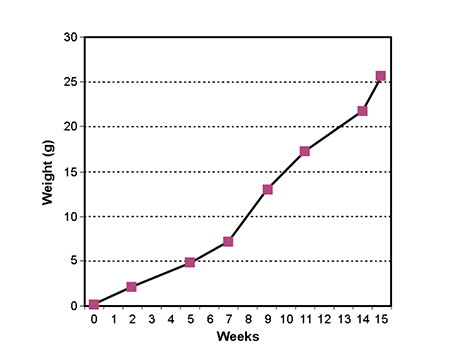Twelve pedigree shrimp lines challenged with the three isolates of TSV

Taura syndrome, caused by the taura syndrome virus (TSV), is a significant disease problem in the commercial culture of Pacific white shrimp. Since first appearing in Ecuador in 1991, TSV spread through most of the industry in Latin America and caused massive losses. The disease reached Texas, USA, in 1995 and decreased shrimp production there by 50 percent through 1998.
Taura syndrome probably crossed the Pacific Ocean to Asia in 1999 when TSV-contaminated wild broodstock (Penaeus vannamei) were sent from Central America to Taiwan. It has since spread to Thailand and Indonesia with movements of contaminated stocks from Taiwan and China. Particularly with the recent global shift toward increased production of Pacific white shrimp, taura syndrome remains a threat to producers.
Domesticated stock
A large number of Pacific white shrimp farmers depend on locally produced broodstock. Local broodstock, however, can be contaminated with pathogens like TSV. They can also suffer from genetic inbreeding and may not be best suited to maximum economic performance.
Farmers therefore increasingly choose to stock domesticated broodstock shrimp that are resistant to TSV and provide reliable commercial performance in pond culture.
Breeding goals, selection
At High Health Aquaculture, Inc., a selective-breeding company based in Kona, Hawaii, USA, the breeding goals are to develop fast-growing, healthy, TSV-resistant shrimp that minimize the risks of taura syndrome. To achieve these goals, the company uses a selection strategy based on shrimp survival in replicated laboratory TSV challenges combined with shrimp growth performance under simulated commercial conditions.
High Health contracts with the Shrimp Pathology Group at the University of Arizona in Tucson, Arizona, USA, a world leader in TSV pathology and shrimp biology, to conduct the virus challenges using purified strains of TSV with representative samples of its shrimp. The studies compare multiple lines of High Health shrimp to determine the best lines for future breeding.
TSV isolates
This summer, the authors conducted a challenge where multiple pedigree High Health shrimp lines were tested using purified TSV isolates from Hawaii, USA; Belize; and Thailand. This was the first study with Thai TSV isolate under controlled conditions with certified specific pathogen-free stocks.
The Hawaii isolate, HI94, was collected during an outbreak of taura syndrome in 1994. As the first isolate of TSV, HI94 is an extensively characterized reference isolate against which other newer isolates are compared.
The Belize isolate, called BLZ02, was collected in Belize in 2002 and has also been studied in detail. BLZ02 is considered a different strain of TSV because of its unique serotypic characteristics, genome sequence, and distinct virulence. In previous challenges with High Health shrimp, BLZ02 was found much more virulent than HI94. It caused significantly higher mortality in challenge studies with both TSV-resistant and susceptible shrimp stocks.
The newest TSV isolate, Thai04, was collected in Thailand this year and purified by the Shrimp Pathology Group this summer. Because P. vannamei farming is rapidly expanding in Thailand and Asia, it is important to know how the Thai strain compares to other TSV strains.
For example, are the TSV-resistant lines that High Health developed using Western strains of TSV also resistant to Thai TSV?
Challenge tests
Twelve same-age pedigree shrimp lines were produced at High Health’s shrimp-breeding center in Kona, tagged, and shipped to the Shrimp Pathology Group, where the lines were challenged with the three isolates of TSV. Both positive and negative control treatments were included in the experimental design.
In the negative controls with unchallenged pedigree lines, survival was essentially 100 percent. In the positive controls (viral challenges with susceptible shrimp), survival in the BLZ02 treatment was only 10 percent – significantly lower than the 50 percent survival for the Thai04 and HI94 positive controls (Fig. 1).

Comparative results

For all three isolates, the TSV-resistant lines had much higher survival than the positive controls, although there were significant differences in survival between the isolates. Survival in the BLZ02 treatment was 88 percent, with 97 percent for the Thai04 and 95 percent for the HI94 treatments. There were no significant differences between pedigree lines within any of the isolates (p > 0.05).
Growth performance of the TSV-resistant pedigree lines was excellent. These shrimp grew 0.1-26 g in 15 weeks – an impressive mean growth rate of 1.7 grams per week (Fig. 2). It was also notable that the virulence of Thai04 was virtually identical to the Hawaii strain in its effects on both TSV-resistant lines and the positive controls.
The Belize TSV strain was more virulent than HI94 and Thai04, which was consistent with earlier work. In 2002, High Health compared multiple TSV-resistant families challenged with TSV isolates from Hawaii and Belize, and found the Belize strain more virulent (Fig. 3). It is noteworthy that between 2002 and 2004 over two generations of selection, the TSV-resistant lines improved in resistance to both isolates of TSV.
There was no significant difference between the TSV-resistant lines in any of the strains, which contrasted significantly with earlier work. It appears the lines have reached nearly complete resistance to Hawaii and Thai TSV, so further improvements in breeding for TSV resistance will be minor.

(Editor’s Note: This article was originally published in the December 2004 print edition of the Global Aquaculture Advocate.)
Now that you've finished reading the article ...
… we hope you’ll consider supporting our mission to document the evolution of the global aquaculture industry and share our vast network of contributors’ expansive knowledge every week.
By becoming a Global Seafood Alliance member, you’re ensuring that all of the pre-competitive work we do through member benefits, resources and events can continue. Individual membership costs just $50 a year. GSA individual and corporate members receive complimentary access to a series of GOAL virtual events beginning in April. Join now.
Not a GSA member? Join us.
Authors
-
-
Brenda White, Ph.D.
University of Arizona
Aquaculture Pathology Group
Tucson, Arizona, USA -

Donald V. Lightner, Ph.D.
University of Arizona
Aquaculture Pathology Group
Tucson, Arizona, USA
Tagged With
Related Posts

Health & Welfare
A study of Zoea-2 Syndrome in hatcheries in India, part 1
Indian shrimp hatcheries have experienced larval mortality in the zoea-2 stage, with molt deterioration and resulting in heavy mortality. Authors investigated the problem holistically.

Intelligence
Aquaculture 2019: Triennial meeting examines global industry status
The triennial Aquaculture 2019 meeting – which also celebrated the 50thanniversary of the World Aquaculture Society – featured all segments of the aquaculture value chain during 104 technical sessions.

Health & Welfare
Born in Hawaii, SPF broodstock shrimp industry faces globalization
The next step for shrimp breeding will be developing animals that aren’t just disease-free, but increasingly resistant to multiple pathogens. The industry is globalizing, with suppliers setting up shop overseas. But its birthplace will always be Hawaii.

Health & Welfare
Blue alternative: High Health introduces SPF blue shrimp to Thailand
Blue shrimp are very similar to Pacific white shrimp, and can be raised under similar conditions. Blues grow faster and tolerate lower water temperatures.


